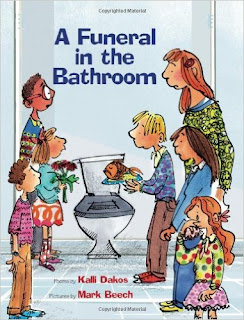 |
| Image retrieved from www.amazon.com |
Bibliography:
Dakos, Kalli, and Mark Beech. A Funeral in the Bathroom: and Other School Bathroom Poems. China: Albert Whitman & Company, 2011. ISBN 9780807526750.
Review and Critical Analysis:
“A Funeral in the Bathroom” by Kalli Dakos is a book of poetry about the school bathroom. These poems are both funny and somber. Students, teachers, and anyone who has attended elementary school (or an elementary school bathroom) will greatly appreciate this book of poetry. They reveal the elementary school bathroom as a place to escape, as a place where accidents happen, as a place to solve puzzles, and as a place of celebrations and tears. The book includes 41 poems and a Table of Contents that lists the title of each poem and its corresponding page number. Each poem features colorful illustrations that show exactly what is happening in the poem - whether it’s a girl sitting on the toilet reading, a puzzle poem that was taped to the bathroom wall, or a student surfing in the flooded bathroom.
Dakos includes poems of all forms in her book. While many of the poems contain a rhyme scheme, some are written in free verse. Each poem is unique in its number of lines and stanzas. While this is the case, Dakos manages to write each poem in a form that would best portray its subject and character. For example, “The Bathroom Dance” is written in squiggly lines all over the page, as though the poem itself is doing the Bathroom Dance. “Emergency” is written in lines with one word each to create short stanzas. This gives the reader the image that this is such an emergency that the writer can’t say more than one word at a time. He finally yells “Emergency!” and leaves the class immediately.
The poems in “A Funeral in the Bathroom” evoke familiar childhood experiences and memories for all readers. The elementary school bathroom is a place for accidents and emergencies, and Dakos represents those experiences well in her poems. However, she best represents the elementary school bathroom as a place of escape for students. Poems such as “Meet Me in the Bathroom” in which two students plan to fake a stomach ache to get out of class and meet at two o’clock in the bathroom remind readers of small chances to talk to friends in the bathroom and take a break from class. “Bathroom Break” is a simple poem about having a little resting time and a little quiet time during your “tinkle time.” Kalli Dakos relates to readers in a unique way by evoking these familiar childhood experiences in the school bathroom.
Mark Beech illustrates the poems in this book with bright colors and with characters containing simple features. His bright colors evoke strong emotions to go along with each poem. The simple features on each character allow them to transform into anyone - ourselves or our elementary school friends. His illustrations add humor to the already humorous poems, and they add sobriety to the already somber poems. In “Crying in the Bathroom,” Beech shows a house that is broken in two, with each piece on either side of the poem, to represent the girl’s broken home. The girl is shown with tears flowing below the poem as well. This, and every poem in the book, could not be better represented than through Beech’s illustrations.
Poem Used to Support Critical Analysis:
There Should Be a Place Kids Can Go
By Kalli Dakos
There should be a place
kids can go
when life has dealt
another blow.
There should be a shuttle
to hitch a ride
into the dark
when we need to hide.
There should be a garden
or a room to pray
when pets die
and friends move away.
There should be a tree
kids can climb
when life is a poem
that’s lost its rhyme.
When life is a poem
that’s lost its rhyme,
kids head to the bathroom
all the time.
“There Should Be a Place Kids Can Go” is my favorite poem in “A Funeral in the Bathroom.” The poem talks about kids needing a place to go when days are hard and there’s nowhere else to go. The school bathroom, in some strange way, provides that place for kids, whether it’s to shed a few tears, let out some anger, or just take a deep breath. The last lines, “When life is a poem / that’s lost its rhyme, / kids head to the bathroom / all the time” evoke the essence of Dakos’s book. The school bathroom is more than a place for “tinkle time.” It’s a place of escape.
I would introduce this poem by asking students, before reading, if they have a place they can go (either at school or outside of school) when they need to take a break. We would briefly discuss those places. Then I would ask, “What are some reasons to go to the bathroom besides to go to the bathroom?” After brief discussion, I would read them the poem and have discussion afterwards about the place of escape in this poem. Did students expect the place to go to be the school bathroom?
Afterwards, I would encourage students to write their own poem or short story about a place they go to escape. When do they go there and why?
No comments:
Post a Comment